2024 State of ESP Buyers’ Top Challenges and Wants
This survey marks the 4th year that Only Influencers and Email Connect have conducted a brief survey with brands. The first three years we focused primary on RFPs and email marketers’ potential plans to switch vendors in the upcoming year. This year we decided to take the focus off of RFPs, and instead examine the top challenges that email marketers are facing. We also delved into what features and functions email marketers value the most in their current or future ESP. The number of questions remained the same, and there is still some overlap that will allow us to make some year-over-year comparisons.
About the Survey Respondents
I say this every year, but it’s true, we got a really good mix of companies responding to the survey. Brands ranged in size from the top of the SMB category all the way up to enterprise-sized email volumes. The biggest changes were a surge in the largest enterprise brands (750+ million annual email volume) from around 15% of respondents up to 25%, exceeded only by an even bigger increase in the second lowest volume category (10-5 million annual email volume) from 19% to 30%. This chart shows how they break out by email volume:
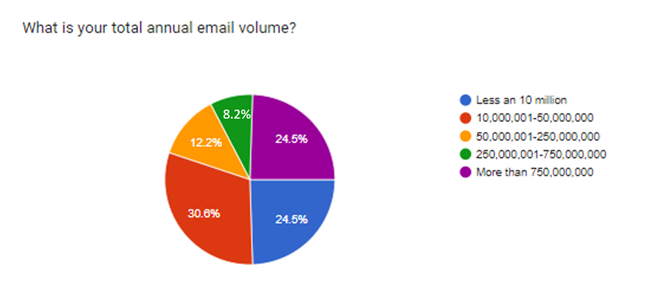
The range of email volumes is valuable to know, particularly as it relates to the top three ESPs section later in this report.
Biggest Email Challenges in 2024
New to the survey this year, we decided we wanted to hear from our respondents regarding their biggest email marketing challenges in 2024. These challenges often lead to the decision to RFP, as many of them are the result of a brand using a legacy platform, rather than one of the nextgen platforms, which continue to gain market share (hmmm, I wonder if there’s a connection?).
The overwhelming winner of biggest challenge in 2024 is “Lack of consolidate customer data”. Nearly 4 in 10 respondents listed this as their biggest challenge. Data lies at the heart of so many digital marketing efforts, not just email. While CDPs were “supposed” to resolve this issue, it remains, at best, an aspiration at many enterprises. Brands that have come close to solving this issue are most likely those on nextgen platforms that feature NoSQL databases, which I’ve written about in the past, most recently here.
Coming up in second place at around 16% of respondents is “Lack of needed features in our ESP platform”. IF that’s not a reason to RFP as soon as possible, I don’t know what it. C-Suite, are you listening to your email marketing teams?? The feature gap between legacy platforms and more modern platforms has widened considerably in the last 5 years. There’s no reason anyone should suffer from feature-envy. Do you know when your current ESP contract expires? If not, that should be the first thing you do after reading this.
Lack of people resources (creative, analytics, IT) was third at 12%, followed by deliverability at 10%. Deliverability is the issue that won’t go away—it will exist as an issue as long as we have email marketing. Regarding people resources, your quickest fix is hiring one of the really good email agencies that have popped up in the last 10 years. Shops like RPE Origin, Shaw/Scott and Inbox Army. You’re welcome!
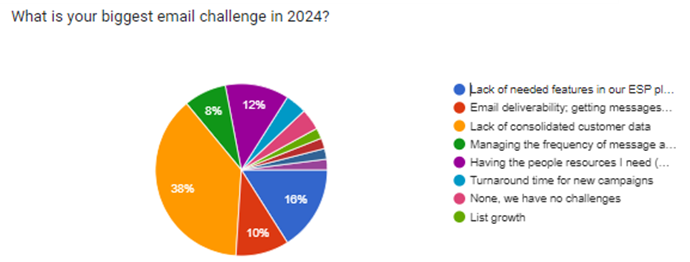
Top Priority for Improving ROI in 2024
Another new question this year centers on what email marketers are making their top priority for improving email ROI in 2024. The top three answers are all—not surprising—data related. Leading the pact at 36% is “Improving segmenting and targeting”. There are two requirements for achieving this: more and better data, and a platform that can leverage that data in real-time. Perhaps, then, it comes as no surprise that, at 18%, the second most checked boxes were “Leverage real-time data” and “Greater use of analytics”. For these two you also need two things: more, and better data, and a platform that can slice and dice that data to optimize your messaging (a bit of déjà vu here….). What about deliverability you ask? Consistent with the results of the previous question, around 8% said that was his or her top priority.
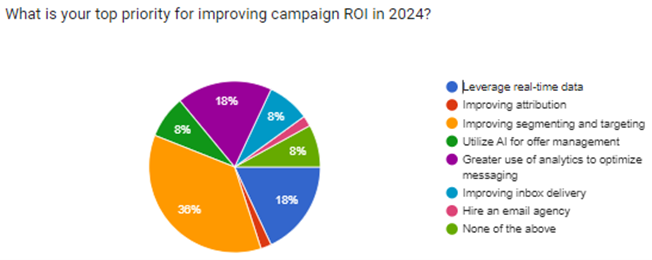
What is/was the Primary Driver of your RFP?
Once again in 2024, the answers to this survey question demonstrate that the “Changing of the Guard” is continuing to impact RFPs and the vendors being included. The #1 reason brands gave for going to RFP this year was, “We have outgrown our existing platform” at 22.4%. This was closely followed by “Want to see what some of the newer platforms offer”, totaling 20.4% of responses.
Coming in at 16.3% is “sick of our current vendor”. Outgrown, see the new stuff, and sick of current vendor collectively came in at around 69% of responses, which is a strong indication that the shift to nextgen platforms from legacy platforms is not going to slow down anytime soon, and may, in fact, be happening even faster. Cost savings at 14.3% remains a minor driver of RFPs.
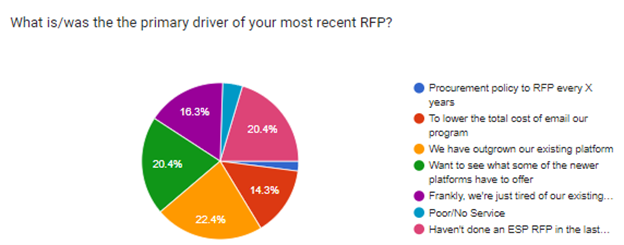
What capabilities are most important in an ESP?
The Big 4 from 2023, remained the Big 4 in 2024, with just a slight reshuffling of position. “Reporting tools/BI”, which was picked by 68% of respondents, and regained first place. In doing so it switched places with “Real-time data”, which dropped this year to 64% of respondents from 72% in 2023.
“Optimization/testing” (62%) and “Client service/support” (60%) finished a little behind the leaders but closed the gap from 2023. Vendors need to take note of these results because the Big 4 is consistent year over year. If you’re not proficient in the first 3 (or getting there), you sure as heck better be exceptional in “Client service/Support”. Of course, the best way to succeed is to nail all four of these.
Rising up the charts with a bullet in 2024 is “CDP functionality built in”, going from 28% in 2023 to 38% this year. At the risk of sounding like a broken record, this is driven by the success of the nextgen platforms built on NoSQL databases. Relational databases are unable to mimic some of the functions of CDPs (all of which are built on--you guessed it—NoSQL databases).
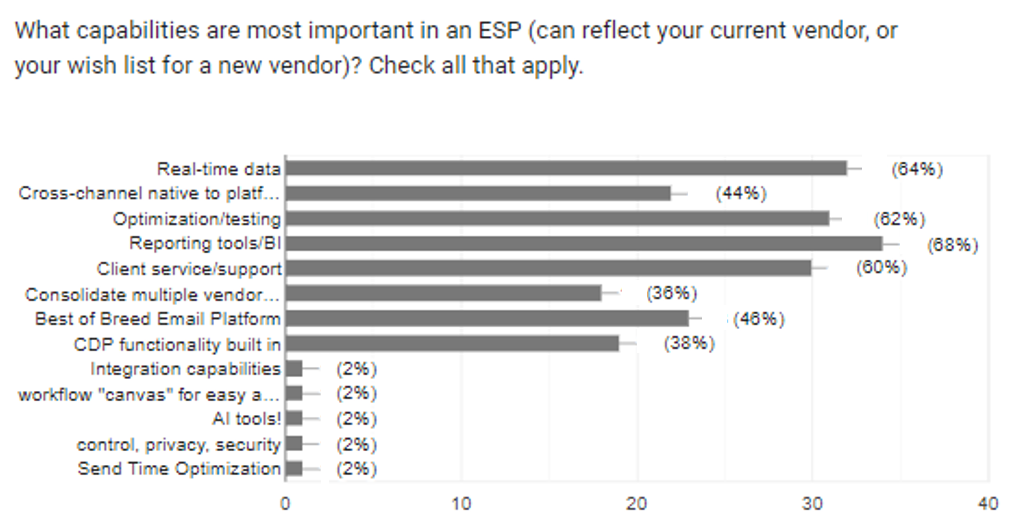
Hot or Not
By all indications, the share of market held by the nextgen platforms is going to continue to increase at the expense of the legacy platforms. Iterable, Braze and Zeta claimed the largest share of interest among enterprise brands (email volume = 250-750+ million emails/year). Oracle, Salesforce, and Epsilon hardly registered any interest at all. This lack of interest has been becoming more pronounced in the last few years as buyers have turned more and more to nextgen platforms (like the aforementioned Iterable, Braze and Zeta). Other ESPs attracting the interest of enterprise buyers include Message Gears, Cordial and Adobe. Confusion over Marigold’s new naming conventions likely contributed to Sailthru (now Marigold Engage) and Cheetah (now Marigold Engage+) underperforming prior year results. We have not seen an actual decline in interest in these two platforms over the past year.
On the other end of the spectrum, among email marketers sending less than 10 million emails a year up to 250 million, Klaviyo continues to lead the pack in buyer interest, but followed closely by Iterable and Braze, who have made ongoing efforts to attract buyers across all volume levels. And Listrak continues to grow its following in the midmarket.
As in prior years, the mix of platforms mentioned by many respondents indicates there still is a lot of confusion around who to include in an email RFP based on brand size and volume and whether or not they are B2C or B2B. Brands relying on the reports issued by Forrester and Gartner need to be very wary of mixing the wrong platforms (something I’ve written about in the past). Remember, picking the wrong ESPs to evaluate is the #1 cause of RFP failure. Brands need to do their homework before starting an evaluation (or better yet, hire a consultant).
Interest in CDPs
Responses to this question have remained remarkably similar over the last three years. Each year, just under 50% of respondents replied that their company had no plans to add a CDP at the moment. And a little over 50%, have one, are in the selection process, or are going to conduct a selection process in the next 12-24 months.
The dividing line between CDPs and ESPs remains blurry, which might be contributing to the hesitation of half our respondents to consider adding a CDP. However, “lack of consolidated customer data” was the #1 issue among our respondents. Deployment CDPs like Simon Data and Blueshift are winning ESP evaluations, while ESPs like Cordial continue to be considered CDPs by industry analysts like the Customer Data Platform Institute. In any event, ESP evaluations must be made within the context of a company’s near-term plans as to whether or not to add a CDP, or whether one is already in place.

Key Findings
1. It’s all about access to, and the leveraging of, data:
A. A lack of consolidated customer data is the overwhelming challenge for brands in 2024, with over a third of respondents picking it.
B. Over a third of respondent lists “improving segmentation and targeting” as their #1 priority for improving ROI in 2024.
2. The “Changing of the Guard” from legacy platforms to nextgen platforms continues to be a major driver of RFPs, with 20% of them being driven by interest in seeing what nextgen platforms have to offer.
3. Legacy platforms continue to lose ground to nextgen platforms when it comes to buyer interest and consideration. It’s highly unlikely that any of them will be able to turn things around absent the launch of an entirely next platform, or the acquisition of one. What’s more likely to happen is that one or more of the legacy platforms sell their business to another ESP, of simply shut the platform down.
4. The overlap between CDPs and ESPs is going to continue to complicate the selection process for brands who rush in without doing their homework. And it’s not going to get any easier any time soon!
As I wrote last year, and it’s truer than ever this year, RFPs are increasingly difficult to manage successfully in a fast-changing vendor landscape populated by a number of legacy and “next gen” platforms, all of whom are competing for the same business. Ongoing platform innovations, CDPs, and an increasing need for 1st party data are going to have a growing influence on how brands perceive the various ESPs, and how the ESPs position themselves for success in the marketplace.
The stakes of getting your RFP right have never been higher. And the selection process has never been more difficult. Choose wisely (or hire us to help)!

 How to resolve AdBlock issue?
How to resolve AdBlock issue? 
